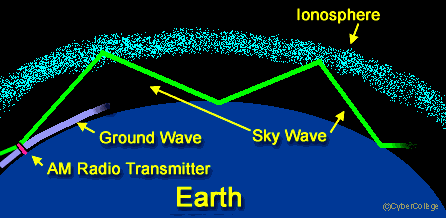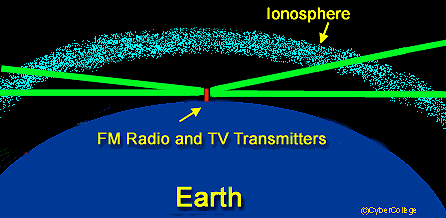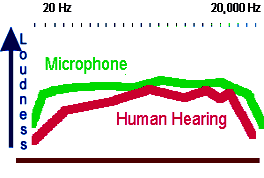Film, Radio and TV - 17 |

AM, FM Waves To understand some of the concepts we introduced in the last module, as well as some of the strange things that happen in broadcasting, we need to take a look at how radio works. First, let's look at the AM radio band (group of frequencies). AM stands for amplitude modulation, which will be explained later. AM radio ranges from 535 to 1705kHz (kilohertz, or thousands of cycles per-second of electromagnetic energy). These are the numbers you see on your AM radio dial, and that stations constantly repeat when they promote themselves. Note in the illustration below that AM radio waves are of a lower frequency than either FM radio or TV waves. Thus, as we will see, after being transmitted, they will behave differently.
Stations can theoretically be placed every 10kHz, along the AM band. This means that there are a total of 117 different channels available for AM radio stations. If it all stopped there, things would be rather simple; but, unfortunately, a lot of other factors come into play. First, you can't put stations on the same frequency that are too close together in a geographic area. They will interfere with each other. And within an area you can't have two stations close together in frequency (too close to each other on the radio dial). So these are the first things that limit the number of radio stations in an area. The good news is that since the signals of stations tend to be limited in their range, you can use some of the frequencies many times--as long as the stations are far enough apart geographically. This is why the United States can have nearly 5,000 AM radio stations with only 117 different frequencies available. |
|
How far an AM station's signal travels depends on such things as the station's frequency (channel), the power of the transmitter in watts, the nature of the transmitting antenna, how conductive the soil is around the antenna (damp soil is good; sand and rocks aren't), and, a thing called ionospheric refraction. (The ionosphere is a layer of heavily charged ion molecules above the earth's atmosphere.) Are you still there? Ionospheric refraction is a very big issue, since AM radio waves can end up hundreds and even thousands of miles away, and in the process interfere with all other stations on the same frequency. Plus, as we'll see in a later module on international shortwave, ionospheric refraction can be good, because it makes possible a lot of other services. Here's how that works.
Note that for AM radio stations the ground wave doesn't go very far. This means numerous stations can be put on the same frequency without interfering with each other--assuming they are far enough apart. (Keep in mind that this drawing can't be anywhere near close to scale and show these things.) The problem arises--if you want to see it as a problem--with the sky wave, which can end up in other states and provinces, or even in other countries. The ionosphere is much more effective in reflecting these radio waves at night. (Incidentally, technically, it's refracting, not reflecting, but the effect is somewhat the same.) That's why at sunset most AM radio stations in the U.S. have to:
This may explain why your favorite AM radio station goes off the air at sunset, or becomes much harder to hear (because of reduced power). FM (frequency modulated) radio and TV waves don't' act in the same way as AM radio waves. For starters, they are on a higher frequency in the RF spectrum. (The name RF, for radio frequency, was obviously named for radio, but when TV came along they just stuck with the name). The FM radio band goes from 88 to 108 MHz (megahertz, or millions of cycles per second). Again, you can see these numbers on your FM radio dial. FM stations must be 200kHz apart at these frequencies, which means that there's room for 200 FM stations on the FM band. But, unlike AM radio stations, FM stations don't end up being assigned frequencies with nice round numbers like 820 or 1240. Thus, an FM station may be at 88.7 on the dial. You may have noticed that FM stations don't reduce power or sign off the air at sunset. That's because ionospheric refraction doesn't appreciably affect FM or TV signals.
For the most part, FM and TV signals are line-of-sight. Although this means that FM stations don't interfere with each other, this characteristic creates a couple of other problems. First, these waves go in a straight line and don't bend around the earth as AM ground waves do. They quickly disappear into space--which may be fine if you are sitting on Mars trying to listen to your FM radio. If not, then the farther away from the FM or TV station you are, the higher you have to have an antenna to receive the FM or TV signal. Note that the earth is round--we hope this doesn't come as a shock to anyone--and, therefore, these signals will literally leave the earth after 50 miles or so. And, there's another problem. Since FM and TV signals are line-of-sight, they can be stopped or reflected by things like mountains and buildings. In the case of solid objects like buildings, reflections create ghost images in TV pictures and that "swishing sound" when you listen to FM radio while driving around tall structures. Of course, the higher the FM or TV transmitter antennas are the greater area they will cover--which explains why these antennas are commonly very tall, or placed on the top of mountains. AM radio doesn't need that kind of advantage, since, as we've seen, AM radio waves don't behave in the same way. Note also from the drawing above that FM and TV signals go through the ionosphere rather than being refracted form it. Again, this means that no matter what the station's power, it's signal will at some point leave the earth.
We need to mention a couple of other things before we leave the discussion of how radio works. We've talked about AM and FM radio, but we really haven't explained the real difference. In fact, there is a lot of difference--and not just a difference in the station numbers on your radio dial. The first type of radio service--the one we've been talking about in the last couple of modules--was AM radio.
In the drawing on the left the RF energy (carrier wave) is not modulated by any sound. There would be silence on your radio receiver. Sound transmitted by an AM radio station affects the carrier wave by changing the amplitude (height) of the carrier wave, as shown on the left. Unfortunately, this type of modulation is subject to static interference from such things as household appliances--and especially from lightening storms. AM also limits the loud-to-soft range of sounds that can be reproduced (called dynamic range) and the high-to-low sound frequency range (called frequency response, to be explained below). FM radio, which came along in the 1930s, uses a different approach than AM. It's virtually immune to any type of external interference, it has a greater dynamic range, and it can handle sounds of higher and lower frequencies. This is why music, with its much greater frequency range than the human voice, sounds better on FM radio. Note above that when the carrier wave of FM radio is modulated with sound, that the distance between the waves, or the frequency of the carrier wave, changes. Thus, AM radio works by changing the amplitude of the carrier wave and FM radio works by changing the frequency of the carrier wave. Frequency Response Frequency relates to the basic pitch of a sound--how high or low it is. A frequency of 20 Hz would sound like an extremely low-pitched note on a pipe organ--almost a rumble. At the other end of the scale, 20,000 Hz would be the highest pitched sound that can be imagined, even higher than the highest note on a violin or piccolo. As we've noted, frequency is measured in Hertz (Hz) or cycles per second (CPS). A person with exceptionally good hearing will be able to hear sounds from 20-20,000 Hz. Since both ends of the 20-20,000Hz range represent rather extreme limits, the more common range used for FM radio and TV is from 50 to 15,000 Hz. (AM radio falls significantly short of this range.) Although the 50-15,000 Hz doesn't quite cover the full range that can be heard by people with good hearing, it covers almost all naturally occurring sounds. Note in the drawing above that the ear does not hear all frequencies of sound at the same loudness, but a good microphone does.
In the next module we'll get back to the development of radio during the period called "The Golden Age of Radio." |
|
To next module
To index © 1996 - 2005, All Rights Reserved.
|



 The term modulation refers to how sound is transported through the air on a radio wave called a carrier wave; or, more accurately, how the sound affects the carrier wave so that the original sound can later be detected by a radio receiver.
The term modulation refers to how sound is transported through the air on a radio wave called a carrier wave; or, more accurately, how the sound affects the carrier wave so that the original sound can later be detected by a radio receiver.
 The sound level or amplitude of sound in radio and TV stations is monitored and adjusted with the help of a volume units meter (VU meter) meter. One model is shown on the left. Audio levels must be carefully controlled in broadcasting to keep noise and distortion from reducing the quality of sound. More information on this can be
The sound level or amplitude of sound in radio and TV stations is monitored and adjusted with the help of a volume units meter (VU meter) meter. One model is shown on the left. Audio levels must be carefully controlled in broadcasting to keep noise and distortion from reducing the quality of sound. More information on this can be